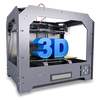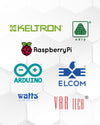
Essential Electronic Components for Beginners: Start Your DIY Journey
Getting started with electronics can feel overwhelming resistors, capacitors, transistors, diodes... where do you even begin? If you've ever looked at a circuit board and thought, "I wish I could build something like that," this blog is your starting point.
At Tomson Electronics, we’ve seen thousands of students and hobbyists begin their DIY electronics journey. What makes the difference between confusion and confidence? It starts with knowing your components. In this beginner-friendly guide, we’ll walk you through the must-have basic components that every aspiring maker should have on hand complete with links to where you can buy them directly from our store.
1. Resistors: The Current Controllers
The resistor is among the simplest components in electronics. They prevent overcurrent in LEDs, microcontrollers, and other components by limiting the current flow.
Real-World Use Cases:
-
Current limiting for LEDs
-
Pull-up/down resistors in digital circuits
-
Voltage dividers for sensors
-
Biasing transistors
-
Timing elements with capacitors
👉 Browse Resistors on Tomson Electronics
2. LEDs: Let There Be Light
Light Emitting Diodes (LEDs) are small, energy-efficient lights used in nearly every project. They’re great for indicating power, signaling status, or even adding flair.
Real-World Use Cases:
-
Power/status indicators
-
Visual debugging in code
-
Light-based alerts in alarms
-
Interactive lighting in wearables
-
Smart home mood lighting
👉 Shop LEDs of All Colors & Sizes
3. Capacitors: Power in a Pulse
Capacitors store and release electrical energy. They’re used in timing circuits, power smoothing, and filtering.
Real-World Use Cases:
-
Debouncing mechanical switches
-
Filtering noise in power supplies
-
Timing in oscillators and delays
-
Coupling/decoupling signals in audio circuits
-
Smoothing out voltage dips in battery-powered devices
👉 Explore Electrolytic & Ceramic Capacitors
4. Diodes: One-Way Street for Current
Diodes only allow current to travel in one direction. This makes them vital for protecting circuits from reverse voltage and for converting AC to DC in rectifier circuits.
Real-World Use Cases:
-
Reverse polarity protection
-
Flyback protection for motors and relays
-
Full-wave and half-wave rectifiers
-
Voltage clamping and regulation
-
Light sensing (with photodiodes)
👉 Buy General Purpose & Zener Diodes
5. Transistors: The Electronic Switches
Transistors are the heart of modern electronics. They can amplify signals or switch devices on and off, acting like an electronic gate controlled by your microcontroller.
Real-World Use Cases:
-
Driving high-power devices like motors and relays
-
Signal amplification in audio circuits
-
Digital logic implementation
-
Voltage level shifting
-
Creating flip-flops and memory units
👉 Choose from NPN, PNP & MOSFETs
6. Integrated Circuits (ICs): Function in a Chip
ICs are chips that perform specific functions timers, amplifiers, logic gates, microcontrollers, and more. For beginners, chips like the 555 Timer IC or 74HC logic gates are great starting points.
Real-World Use Cases:
-
Generating precise time delays (555 timer)
-
Building logic circuits
-
Creating audio oscillators
-
Signal conditioning
-
Memory or display drivers
7. Switches & Push Buttons: User Inputs
Switches allow humans to interact with electronics. Whether it’s turning on a device or resetting a counter, buttons are the most tactile form of input.
Real-World Use Cases:
-
Manual resets or toggles
-
Menu navigation in DIY interfaces
-
Triggering security systems
-
Mode selection in embedded projects
-
User input in games or quizzes
👉 Shop Push Buttons & Toggle Switches
8. Power Supply Modules: Fuel Your Circuits
Electronics need the right kind of power. Power supply modules convert AC to DC, or step down voltages for your components.
Real-World Use Cases:
-
Powering Arduino and Raspberry Pi
-
Battery charging systems
-
Voltage regulation in motor drivers
-
Step-up/down in wearable tech
-
Breadboard prototyping with 3.3V/5V
👉 Browse Power Supply & Converter Modules
9. Breadboards & Jumper Wires: Build Without Solder
Breadboards let you prototype without soldering, and jumper wires make the connections. Every beginner project should start here.
Real-World Use Cases:
-
Testing circuit ideas before soldering
-
Learning how to connect components
-
Modular system development
-
Group learning and demonstrations
-
Rapid prototyping and debugging
👉 Get Your Breadboards & Wires Here
10. Microcontrollers: The Brains Behind It All
Microcontrollers like the Arduino Uno, ESP32, or Raspberry Pi Pico are small computers that run your code and bring all components together.
Real-World Use Cases:
-
Home automation controllers
-
Weather monitoring systems
-
Robotics and motion control
-
Smart farming or IoT projects
-
Interactive art and installations
👉 Shop Arduino, ESP & Other Development Boards
Starter Kits: Get Everything in One Go
If you're unsure where to start, a starter kit with essential components is the best way to begin. It ensures compatibility, includes learning materials, and gets you hands-on fast.
Final Thoughts: Start Small, Think Big
Starting with electronics doesn’t require expensive gear or a PhD. All it takes is curiosity, a few core components, and a willingness to tinker. With the right building blocks and a great supplier behind you you’ll be amazed at how quickly your skills (and your circuits) come to life.
So grab your multimeter, power up your breadboard, and explore the electrifying world of DIY electronics. 🔗 Start Shopping Now at Tomson Electronics



